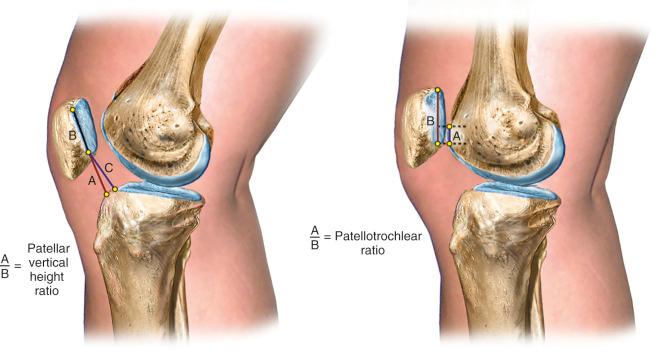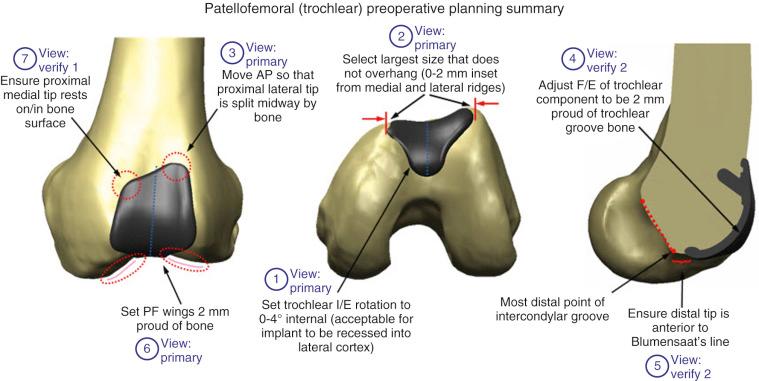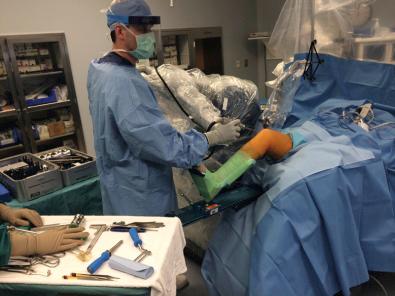Physical Address
304 North Cardinal St.
Dorchester Center, MA 02124
Patellofemoral arthroplasty (PFA) is a viable option for symptomatic patients in whom severe joint damage and loss of joint space are present in the patellofemoral (PF) compartment but not the tibiofemoral compartments. Although early reports of this procedure were disappointing, improvements in product materials, design, and robotic technology, as well as a better understanding of patient indications, have improved the expected outcome.
Symptomatic patients who have severe joint damage and loss of joint space in the PF compartment but not in the tibiofemoral compartments
Symptomatic secondary PF arthritis associated with congenital trochlear dysplasia or PF arthritis after joint dislocation or chronic subluxations
Secondary PF osteoarthritis from trauma or fracture
Failed lengthy course of nonoperative treatment measures
Indications for PFA include symptomatic secondary PF arthritis that is associated with congenital trochlear dysplasia or after joint dislocation or chronic subluxations that are unresponsive to nonoperative and operative measures. Secondary PF osteoarthritis from trauma or fracture are other frequent indications. Although primary isolated PF osteoarthritis is an indication for PFA, it is important to note that some studies reported that patients with this diagnosis were more likely to have progression of tibiofemoral arthritis than patients with posttraumatic arthritis or dysplasia.
Patient candidates typically have severe anterior knee pain, swelling, and stiffness that limits daily activities. A lengthy course of nonoperative treatment that includes nonsteroidal antiinflammatory medication, steroid injections, physical therapy, and weight control fails to alleviate the anterior patellar pain. In our opinion, the patient should be younger than 60 years, although consideration may be made for those older than 60 years, if no contraindications exist, and the tibiofemoral compartments are not arthritic or symptomatic.
Many patient candidates for PFA will have undergone multiple prior failed surgical procedures such as lateral release, arthroscopic debridement and chondroplasty, extensor mechanism realignment, medial patellofemoral ligament (MPFL) reconstruction, or an articular cartilage procedure such as autologous chondrocyte implantation (ACI) or osteochondral autograft transfer. In our prospective study, 76% of patients who underwent PFA had undergone these types of prior PF procedures that subsequently failed. It is important that the patient has realistic expectations regarding what this operation may and may not accomplish. At our center, most patients are able to walk without support within approximately 2 to 3 weeks postoperatively, and the majority return to daily activities within 4 to 6 weeks. Light, low-impact activities such as walking, swimming, golfing, light hiking, and bicycling can often be performed by 3 months. However, running and high-impact athletics or occupational activities are not advised and, in fact, should be avoided; it is essential that the patient understands and accepts these limitations of the procedure. High flexion-repetitive activities may induce a mild effusion because the patella polyethylene replacement articulates with the tibiofemoral articular cartilage.
The principal contraindication to PFA is tibiofemoral joint arthritis (articular cartilage deterioration and/or joint space narrowing on standing posteroanterior [PA] radiographs) owing to the evidence that this is the leading cause of failure requiring total knee arthroplasty (TKA). In addition, uncorrected excessive varus or valgus malalignment (greater than 3 degrees), uncorrected PF malalignment, knee ligament instability, inflammatory arthritis, and prior or active infection are contraindications. Patients with patella alta may require distalization of the tibial tubercle. Patients with complex regional pain syndrome, diabetes, knee arthrofibrosis (excessive extension or flexion contracture), chondrocalcinosis, or rheumatoid arthritis are not considered candidates. Patients older than 60 years of age or those who are obese (body mass index [BMI] >31) are also usually not candidates for PFA. Osteopenia (bone mineral density T score between −1.0 and −2.5 standard deviations below normal) and osteoporosis (T score less than −2.5) are contraindications for this operation. Other contraindications include failure to treat the patient with all conservative measures, a history of meniscectomy that is associated with tibiofemoral compartment joint damage or narrowing, noncompliance with rehabilitation, and unrealistic expectations for future activity levels. Magnetic resonance imaging (MRI) is frequently obtained to rule out associated tibiofemoral compartment osteoarthritis that would decrease the success rate. It is realized in younger patients that PFA is a temporary procedure to buy time before TKA, which can later be successfully performed. Younger patients who undergo corrective tibial or femoral osteotomy for varus or valgus malalignment could then be future PFA candidates.
Tibiofemoral joint arthritis
Uncorrected varus or valgus malalignment >3 degrees
Uncorrected patellofemoral malalignment
Uncorrected knee ligament deficiency
Inflammatory arthritis, rheumatoid arthritis
Complex regional pain syndrome, knee arthrofibrosis, chondrocalcinosis
Age ≥60 years
Body mass index >31
Osteopenia or osteoporosis
There are two main types of PFA implants based on the trochlear preparation method. So-called first-generation implants replace worn cartilage without altering the shape of the subchondral bone ( Table 37-1 ). The trochlear implants are placed using an inlay or onlay technique, and their positioning is dependent on the patient's trochlear anatomy. These designs generally have a narrow, excessively deep trochlear component that is too constraining and causes many problems related to patellar catching, poor tracking, and continued anterior knee pain.
| Product | Clinical Study (References) | Comments |
|---|---|---|
| KineMatch PatelloFemoral Replacement (Kinamed, Inc., Camarillo, CA) | Third-generation CT-modeled implant | |
| Custom Performa Knee Patellofemoral Arthroplast (Biomet Orthopedics, Warsaw, IN) | Third-generation CT-modeled implant | |
| MAKOplasty Partial Knee Resurfacing (MAKI Surgical Corp., Ft. Lauderdale, FL) | Third-generation, robotic technology, CT-modeled implant; no clinical studies at time of writing | |
| Avon (Stryker, Kalamazoo, MI) | Second-generation off-the-shelf implant; most widely studied PFA | |
| Vanguard Patellofemoral Replacement System (Biomet Orthopedics) | Second-generation off-the-shelf implant; only 1 study that mixed results of 3 prostheses together | |
| Gender Solutions PatelloFemoral Joint (Zimmer, Warsaw, IN) | Second-generation; only 1 study that mixed results of 3 prostheses together | |
| Journey Patellofemoral Joint System (Smith & Nephew, London, UK) | Second-generation off-the-shelf implant | |
| Hermes (Ceraver, France) | Second-generation off-the-shelf implant | |
| iBalance Patellofemoral Joint System (Arthrex, Naples, FL) | Second-generation off-the-shelf implant; no clinical studies at time of writing | |
| SIGMA High Performance Partial Knee (DePuy Synthes Joint Reconstruction, Warsaw, IN) | Second-generation off-the-shelf implant; no clinical studies at time of writing | |
| Femoro Patella Vialli (FPV) (Wright Medical Technology, Arlington, TN) | Second-generation off-the-shelf implant; design of prosthesis “questionable” | |
| Richards Model I, II, III (Smith & Nephew) | First generation; replaced with Journey | |
| Lubinus Total Patella Glide Replacement (Waldamer Link, Hamburg, Germany) | First generation; all investigators discontinued prosthesis | |
| Low Contact Stress PatelloFemoral Joint (DePuy Orthopedics) | First generation; company discontinued | |
| Autocentric (DePuy Orthopedics) | First generation; discontinued |
Second-generation PFA implants replace the trochlea based on the femoral trochlear groove of TKA implants. * The shape of the trochlear groove varies greatly between models; from deep, highly constrained models to open, unconstrained models. The patellar component may be shaped as a dome, have facets, or be asymmetrical in design.
* References
The term third-generation describes PFA systems that are implanted using 3-dimensional models of the patient's anatomy obtained from computed tomography (CT) scans in which either a custom prosthesis is created (KineMatch PatelloFemoral Replacement ; Custom Performa Knee Patellofemoral Arthroplast, Biomet Orthopedics ) or robotic technology (our preferred technique) is used for implant sizing and orientation and bone resection (MAKOplasty Partial Knee Resurfacing, Stryker Orthopaedics).
A thorough history is required including documentation of prior surgical procedures and conservative treatment measures, patellar dislocation or subluxation episodes, and other knee joint injuries. Symptoms typically occur in the anterior or retropatellar regions and are worsened with stair climbing, walking on uneven ground, kneeling, squatting, and prolonged sitting.
The comprehensive physical examination includes a complete PF examination, discussed in detail in Chapter 35 , to assess patellar tilt, subluxation, mobility, Q-angle, and lower limb rotational alignment (femoral internal torsion, tibial external torsion). The integrity of the MPFL and medial soft tissue stabilizers is assessed by the amount of lateral patellar displacement (glide), which normally is 1 quadrant of patellar width (at 0 and 20 degrees of flexion). The presence of an active lateral patellar subluxation with knee extension (J sign) indicates deficient medial stabilizers and, often, patella alta. A lack of normal medial translation (<10 mm, 20 degrees of flexion) indicates excessive tightness of the lateral retinacular tissues and often an excessive lateral patellar compression syndrome, requiring Z-plasty lengthening and soft tissue balancing at surgery (to be discussed). The patella and all surrounding tissues are palpated to localize pain. The medial and lateral joint lines are also inspected for any tenderness, indicative of tibiofemoral joint involvement that may contraindicate PFA.
All knee ligament tests are conducted as described in Chapters 7 and 17 .
The patient's gait, range of knee motion, lower extremity and hip muscle strength, and neurovascular status are evaluated.
Radiographs taken during the initial examination include standing anteroposterior (AP) at 0 degrees, lateral at 30 degrees of knee flexion, weight-bearing PA at 45 degrees of knee flexion, and PF axial views. A true lateral radiograph in which the distal and posterior aspects of the femoral condyles are perfectly superimposed should be obtained to evaluate trochlear depth. Measurements of patellar height and patellar trochlear contact are made on lateral radiographs ( Fig. 37-1 ). Double-stance full-standing radiographs of both lower extremities, from the femoral heads to the ankle joints, are obtained in knees in which varus or valgus lower extremity alignment is detected on clinical examination. MRI is required to determine the cartilage status of the entire knee joint, along with all other soft tissue structures.

The PFA operative technique described in this chapter that the senior author (F.R.N.) has used since 2008 uses a cemented implant (RESTORIS MCK [Multicompartmental Knee] PF implant system, Stryker Orthopaedics) that is positioned using 3-dimensional modeling and computer-assisted robotic surgical navigation (Robotic Arm Interactive Orthopedic System [RIO], Stryker Orthopaedics). Before surgery, customized CT scans (CT Scanning Protocol Knee Arthroplasty PN 200004) are obtained with the patient lying supine with a motion rod attached to the operative leg. The CT scans are saved in DICOM 3 format and transferred to software that processes the hip, knee, and ankle data to create 3-dimensional bone models of the femur and tibia. Calculations made for implant sizing, orientation, and alignment are based on the patient's bone anatomy. Fine tuning of the component position and orientation based on patient-specific anatomy and cartilage thickness is completed intraoperatively. The primary preoperative planning steps for the trochlear implant are summarized in Figure 37-2 (see MAKOplasty Partial Knee Application User Guide 206388 Rev 01 and Surgical Technique and Planning Guide #201844, Stryker). The recommended positioning limits are:
Trochlear internal/external rotation: 4 degrees internal to 0 degree (ideal, 0 degree rotation), which is considered acceptable for the implant to be recessed into an abnormal prominent lateral trochlea to avoid internal rotation of the implant. Every degree of internal rotation medializes the trochlear groove approximately 0.5 mm and raises the patellar jump height approximately 0.3 mm. External rotation of the trochlear component is not recommended because it will decrease the lateral patellar jump height and increase the risk of lateral patellar subluxation.
The largest size trochlear implant is selected that will not overhang. There should be 0 to 2 mm of inset from the medial and lateral ridges and there should be no interference with the anterior cruciate ligament (ACL).
Alignment is set between 3 degrees varus and 2 degrees valgus (ideal, 0 to 2 degrees varus). Every degree of varus/valgus rotation translates the trochlear groove entrance by approximately 0.6 mm. The trochlear component should not be placed in more than 2 degrees of valgus because this will align the trochlear groove away from the anatomic axis of the femur and increase the risk of lateral patellar subluxation. The PF component trochlear groove pathway is curved proximally 6 degrees to align with the anatomic axis when the implant is planned at 0 degrees of varus-valgus.
The flexion-extension of the trochlear component is adjusted to be approximately 2 mm proud of the trochlear groove bone. This should be set between 5 degrees of flexion and 5 degrees of extension. Verification should be made that the distal tongue does not violate the intercondylar notch and cause ACL impingement. The PF distal tip should be anterior to Blumensaat's line.

The reader is referred to the MAKOplasty Partial Knee Application User Guide 206388 Rev 01 and Surgical Technique and Planning Guide #201844, Stryker Orthopaedics, for the Robotic RIO PFA, which are summarized in this chapter.
The surgical positioning of the lower limb, along with the robotic arm instrumentation, is shown in Figure 37-3 . A femoral array has been placed 8 cm above the patella. The surgeon views the operative resection of the trochlea on the screen (not shown). The leg is positioned in a leg holder that allows easy adjustment of knee flexion and controls rotation. There are multiple steps required in the registration of the lower limb and trochlear anatomy of the patient that are summarized in the user and planning guides.

With the knee flexed to 30 degrees, an anteromedial skin incision is made adjacent to the medial border of the patella, extending from the superior border of the patella to the top of the tibial plateau. The incision is extended proximally or distally as required for adequate visualization. The subcutaneous tissues are undermined and retractors placed to expose the medial retinaculum. An incision in the quadriceps tendon 3 cm above the patella (senior author's choice) or a medial subvastus or midvastus arthrotomy is created through the medial retinaculum, capsule, and synovium. The length of the incision and arthrotomy must be sufficient enough to enable patellar retraction for insertion of the trochlear implant and femoral registration. All compartments and cruciate ligaments are inspected to confirm the indications for PFA. The fat pad is partially removed as required and any synovium above the trochlea for exposure. The patella is reflected laterally to expose the PF joint space.
The techniques for registration are followed as specified in the surgical technical guide. Patient landmarks are collected and registered to verify femoral and tibial checkpoints. Bone registration is performed, but osteophytes are not removed. The cartilage in the trochlear groove and distal femur is mapped to ensure smooth transition from the implant to the femoral condyles and femoral component. The RIO is placed in the operative field and registration and verification performed of the position of the robotic arm and cutting tool tip.
Become a Clinical Tree membership for Full access and enjoy Unlimited articles
If you are a member. Log in here